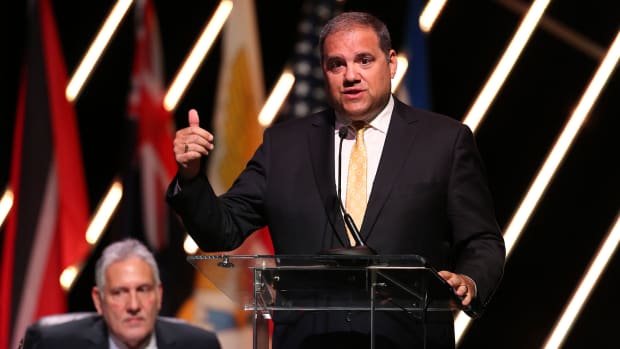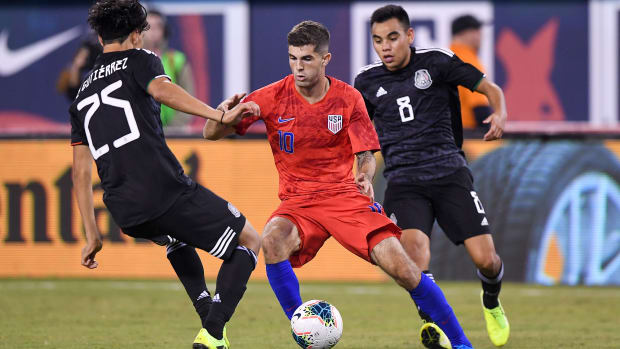A meeting to determine the coronavirus-era international calendar is set for this week, with the clarity it yields giving Concacaf its marching orders to set its path to Qatar 2022.
There’s a virus-free parallel soccer universe out there that’s enjoying the hell out of its simultaneous European Championship and Copa América tournaments. In that universe, the major domestic leagues were decided weeks ago, one fortunate Concacaf country is basking in the historic glow of an inaugural Nations League title, and World Cup qualifying is just around the corner.
More than three months into the pandemic, that universe seems like a fantasy. And yet it’s still a lot easier to imagine than our real one. Here, some countries still haven’t come to terms with the severity of the coronavirus, and different regions of the world are at very different states of recovery and re-emergence. It’s one thing to get a behind-closed-doors domestic league back up and running. It’s entirely another to restart international play, where a devastated competition calendar, travel restrictions and a wide variety of player fitness and availability issues are just some of the obstacles.
Time will become another issue relatively soon. The crunch is coming. There’s an Africa Cup of Nations over the winter and the Euro, Copa and 2021 Concacaf Gold Cup are now (re)scheduled for next summer. The 2022 World Cup is supposed to kick off that November, and qualifying has yet to begin in Europe or the Americas. Somehow, the group stage of the UEFA and Concacaf Nations League needs to be crammed in as well, not to mention two rounds/windows of Gold Cup qualifying. It’s a complex puzzle to put together, and we still have no idea how many pieces come in the box.
There’s some expectation that FIFA will provide clarity on that this week. Until the number of international windows and match days is known, there’s no way Concacaf or any other confederation can determine definitively what its competitions or qualifying format are going to look like. On Thursday, the FIFA Council will meet by video conference. Agenda item No. 5 is the men’s international match calendar.

Concacaf and U.S. Soccer Federation officials will be watching closely, hoping that with some clarity, a competition framework might follow. Concacaf remains committed to finishing the 2019-20 Nations League, the first installment of an event designed to accelerate the development of the region’s lower- and mid-tier national teams. Although that development is furthered during the group stage and not by the four-team final round, Concacaf’s interest in cementing the legitimacy of the new competition—not to mention the revenue that’ll come from four games featuring the USA, Mexico, Costa Rica and Honduras—means it’s unlikely to be sacrificed.
Those games were supposed to be played in Houston and Dallas this month. The next available international window is during the first week of September. That’s when Concacaf World Cup qualifying, and the USA’s participation in the Hexagonal, was supposed to begin. If it’s safe to play and if the potential travel hurdles can be resolved, Concacaf will have to decide whether to wrap up the Nations League and get it out of the way, kick off qualifying as originally scheduled or allow teams to play friendlies.
Why would it opt for the latter? National teams haven’t played in months. The USA hasn’t kicked a ball since Feb. 1, and coach Gregg Berhalter hasn’t been able to field something resembling his first-choice squad since last November. World Cup qualifying may not be the best way to start back up again. In addition, the composition of the Hex was supposed to be based on the June FIFA ranking (top six in Concacaf qualify). However, countries on the bubble—notably El Salvador, Canada, Curaçao and Panama—were unable to play internationals in March and June. There’s a feeling inside Concacaf that starting the Hex without offering those teams that last chance to earn their way in would be unfair.
All the aforementioned may be moot in the end, however, as significant doubts remain at Concacaf and the USSF that September internationals will be possible. Even if UEFA is able to give it a go—the second edition of its Nations League is supposed to start, highlighted by a Sept. 8 rematch of the World Cup final between France and Croatia—the work done by European countries to get their domestic leagues up and running (not to mention the ease of travel) puts them far ahead of those in Concacaf and CONMEBOL. Costa Rica is the only significant country playing in the former, while Brazil—hit hard by the virus—just staged a few matches last weekend. If the coronavirus truncates or derails the MLS is Back Tournament in Orlando, for example, it’ll be even less likely that a significant number of Concacaf players are national-team fit by early September.
So the number of international windows settled upon by FIFA will play the largest role in dictating how the schedule unfolds from here. FIFA could add or subtract windows, and/or change their length—UEFA is pushing for windows that would accommodate three games. Concacaf’s original plan was to fit its entire World Cup qualifying schedule, as well as the 2021-22 Nations League, 2021 Gold Cup qualifying and the inter-confederation World Cup playoffs, into the 11 non-Gold Cup windows from September through June 2022. The Gold Cup finals can’t double as World Cup qualifying. Concacaf owns the tournament, while individual national federations own the rights to the qualifiers they host.
If the September games are lost, then sacrifices or format changes likely would be required. There’s technically still room for the Hex. But there’s a problem if Concacaf insists on allowing the bubble teams to play the friendlies lost this spring, or if it refuses to shorten its 2021-22 Nations League schedule. The USA and Mexico would like to see the Hex remain in place, in part because of the margin for error it affords (we now know how large that margin is thanks to Graham Zusi, Jurgen Klinsmann and Bruce Arena), and in part because of the popularity of the two countries’ qualifying home-and-home games.

Concacaf will have to consider scrapping the Hex, however—and it is considering it—in order to allow the bubble teams to play for passage to the final round while simultaneously reducing the qualifying schedule. The group stage of an eight-team final round, for example, can be played over three windows instead of five. The playoff for the region’s third-automatic World Cup berth, followed by the playoff between the loser (originally the fourth-place finisher in the Hex) and the survivor of the path created for Concacaf’s smaller countries, would shrink the qualifying competition to the five windows required for just the Hex. How Concacaf structures the knockout rounds for its smaller nations, 12 of which still need to play Gold Cup qualifiers, adds even more complexity.
Another option would be to stage a final round featuring three groups of four. There’d be no complaints about teams being left out unfairly, and sending the best runner-up straight to meet the survivor of Concacaf’s small-country path would reduce qualifying by an additional window. The USA and Mexico certainly wouldn’t meet under this format, and with the pursuit of an automatic berth reduced to just six games, the draw and then a few bounces of the ball will have a lot to say about their World Cup fates.
Concacaf is hoping to have a revised international calendar in hand shortly after the FIFA meeting concludes.
USSF technical director Earnie Stewart said on a federation podcast recently that U.S. Soccer and Concacaf continue to meet weekly to discuss news and scheduling possibilities.
“There’s no decisions made and there’s a lot of scenarios out there right now of what that needs to look like,” Stewart said. “Nobody knows what we have ahead of us. We’ve already missed out on the March dates. We’ve missed out on the June dates. It kind of looks like the September dates at [this] moment might not be there either. The possibility of qualifying and losing FIFA dates comes closer and closer. FIFA is talking about adding dates as well. … Nobody knows the dates as of today and how many FIFA dates there will be going forward.”
Finishing the European seasons wasn’t easy, but at least leagues knew how many games they needed to schedule and who was playing. International soccer hasn’t had that luxury. But there should be a framework, finally, by the end of this week.